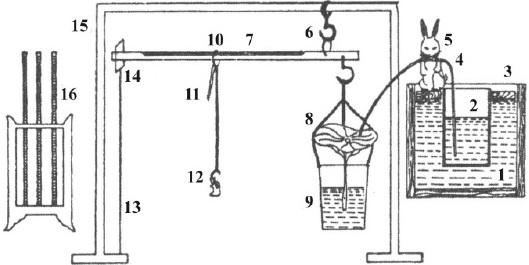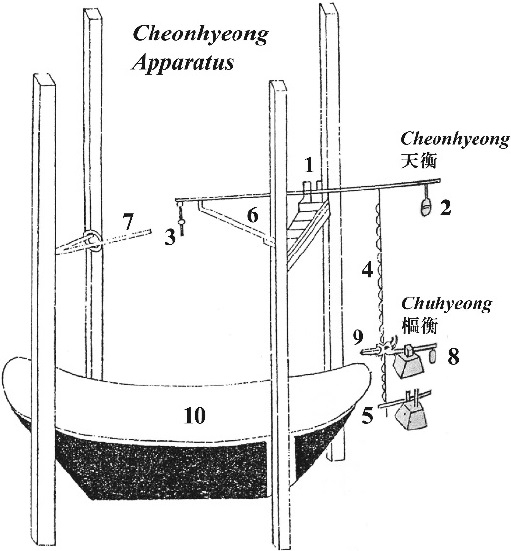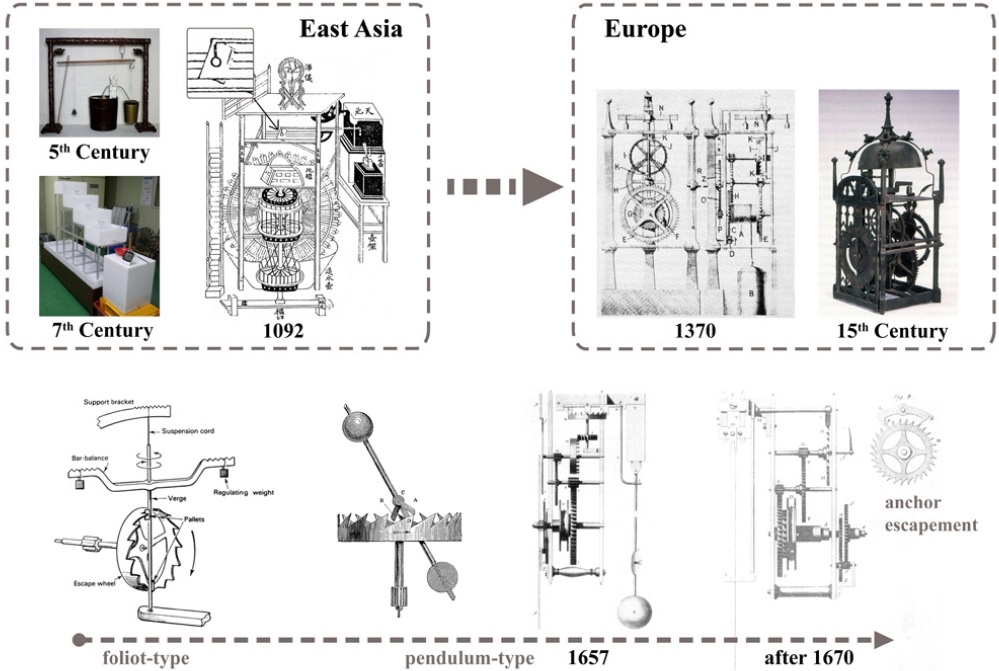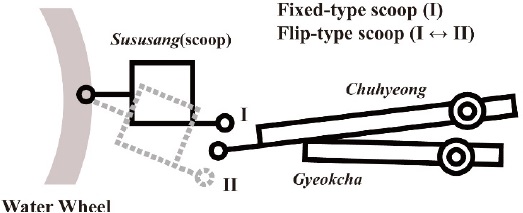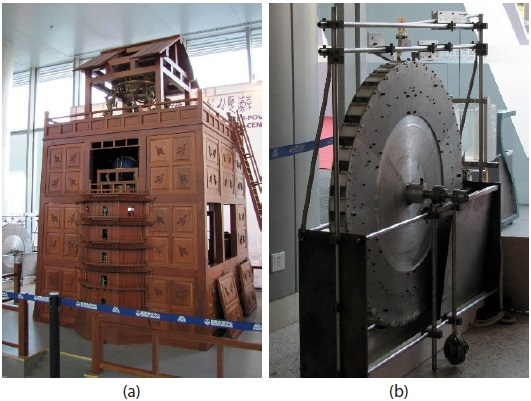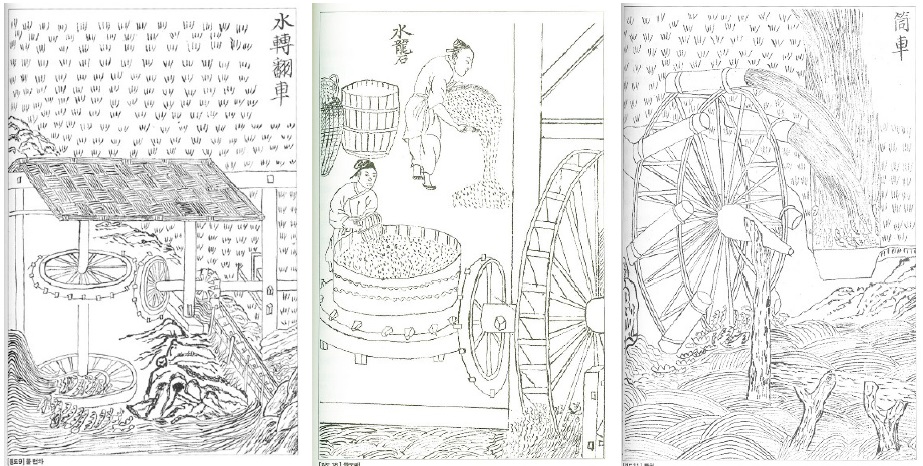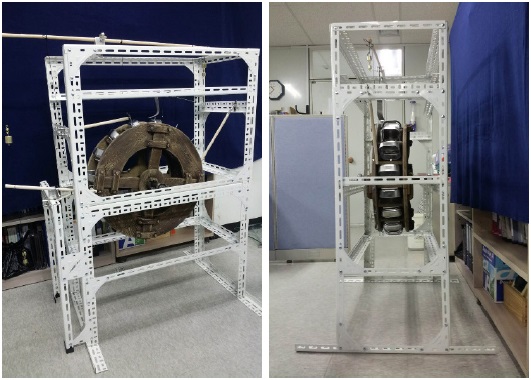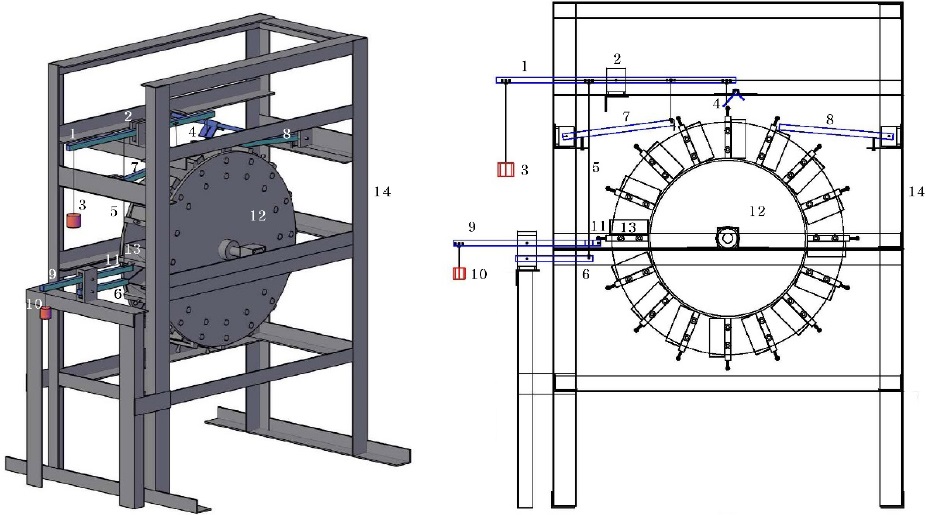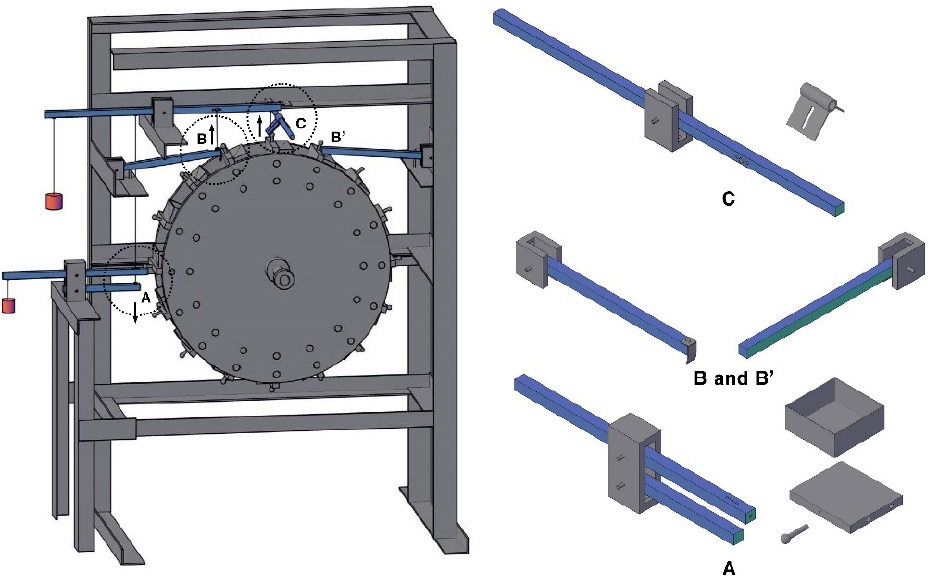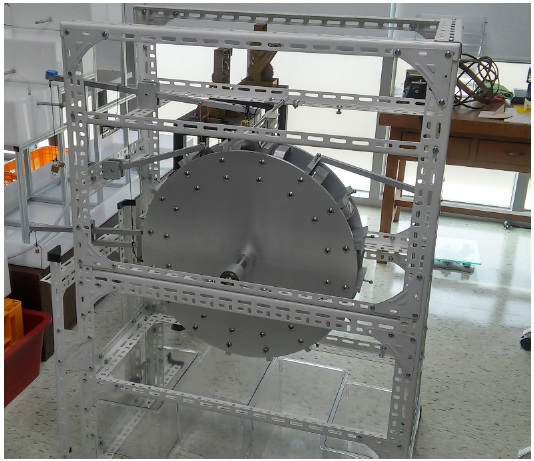Heumgyeonggaknu (欽敬閣漏) was an automatic clepsydra made by Jang Young-sil in 1438. Gasan (假山, imitation mountain) in Heumgyeonggaknu had 37 time-signal puppets and informed people of the time of day. Gasan was decorated with a five-colored cloud, and it worked as an astronomical clock according to the Sun and seasons. We analyzed the modeling of the external structure through the study of Kim et al. (2011, 2013), based on the annals of the Joseon dynasty. We analyzed the internal structure through related relics (Jagyeoknu in Korea, a restoration model of Shui Yun Yi Xiang Tai (水運儀象臺, a water-driven astronomical clock tower made in 1092) in China, Japan, etc.) . In this study, we examined the form of the Cheonhyeong (天衡, oriental escapement) apparatus and the water wheel to understand the structure of the power system in Heumgyeonggaknu. We drew a basic design and made an experimental model of the water wheel control system.
Cheonhyeong was a type of scale device. According to the Xin Yi Xiang Fa Yao (新儀象法要) written by Su Song (蘇頌, 1020–1101), it was used to control the water wheel installed inside Shui Yun Yi Xiang Tai (水運儀象臺). It measured the weight of Sususang (受水箱, scoop), which hung on the water wheel. The Cheonhyeong apparatus was first found in the Steelyard Clepsydra (稱漏), made by Li Lan (李蘭) in the 5th century, Northern Wei (北魏, 386–534 A.D.).
Fig. 1 is a structural drawing of the Steelyard Clepsydra. If a constant level of water in Dongbun (see Fig. 1, No. 2, hereafter referred to by its number) was supplied to Dongho (9), hung on Ching (7), through Galo (4), it would let us know how much time had passed by measuring the weight of the water. To maintain a constant water pressure in the PaSuho (播水壺, water supplying vessel), a water floating vessel was used in the Steelyard Clepsydra. The water supplied from the vessel (Dongbun) was filled in Dongho (9) at a constant speed. As water was continuously filled, a lapse of time could be produced by making a scale horizon, moving the weight (12) that hung on the scale. As time passed (as water was filled), the position of weight was manually moved left, and it made horizon. This way of using the scale was also applied to Shui Yun Yi Xiang Tai.
Fig. 2 is the Cheonhyeong apparatus, which was applied to Shui Yun Yi Xiang Tai. There were two Cheonhyeong apparatuses in Shui Yun Yi Xiang Tai1. The first apparatus generated signals by measuring the weight of Sususang of the water wheel. (This was called “Chuhyeong” in Xin Yi Xiang Fa Yao. From now on, we refer to this as the Chuhyeong apparatus.) The second Cheonhyeong apparatus controlled the running of the water wheel according to a signal generated by the Chuhyeong apparatus.
The running mechanism of Cheonhyeong is as follows: Gyeokcha (see Fig. 2, No. 9, hereafter referred to by its number) of Chuhyeong, senses the weight of the water filled in Sususang of the water wheel. As the water in Sususang is getting filled, Gyeokcha pushes Cheonhyeonggwanseol (5). At this moment, Cheonjo pulls Cheonhyeong, and Cheongwan (3) and Jwacheonswae (6) go up. The water wheel spins, and Cheongwan and Jwacheonswae brake the water wheel. By repeating this operation, the spinning of the water wheel is controlled. Ucheonswae (7) prevents the backspin of the water wheel. The weight of Cheonhyeong is Cheongwon (2), and the weight of Chuhyeong is Chugwon (8). In the middle of Cheonhyeong there is an axis made with steel. It passes through Cheolhyeop (1). Poured water from Sususang of the water wheel fills ToeSuho (10).
Meanwhile, in China, a single-stage clepsydra (單級浮箭漏) was made in the 1st century B.C.. A two-stage clepsydra (二級補償型浮箭漏) was made in the early years of the East Han dynasty, a three-stage clepsydra (三級補償型浮箭漏) was made in the middle of the 4th century, a steelyard clepsydra was made in the 5th century, and a four-stage clepsydra (四級補償型浮箭漏) was made in the 7th century during the early years of the Tang dynasty (Pan 2005). Increasing the number of vessels of the clepsydra was an advanced technique that achieved a constant flow velocity. Using Dongbun floating on the water, Ching (秤, scale) on the steelyard clepsydra, and a four-stage PaSuho on the clepsydra, a constant flow velocity was maintained and measured. Finally, these were combined to control the power of the water wheel and became the main components of the water wheel control system.
In Europe, escapement was used to increase the accuracy of mechanical clocks. Escapement had been used since the 14th century. At first, a foliot type of escapement was generally used before Huygens’ pendulum-type escapement was applied in 1657. Fig. 3 shows the changing process of how fluid was controlled in the clepsydra using mechanical escapement from the 14th century to the 17th century2. The method of escapement used in Europe was already similar to methods of controlling water used in China and nearby countries. This controlled the water level by using a scale, such as a steelyard clepsydra, or by placing several advanced vessels into a mechanical escapement from Europe3.
A preceding study (Kim et al. 2011, 2013) reported that the main power of Heumgyeonggaknu results from a method of running the water wheel and a two-stage clepsydra with an overflow function. To rotate the water wheel at a constant speed, a device to control the running of the water wheel is needed. The Cheonhyeong apparatus mentioned earlier is an effective way to control the running of the water wheel. However, in the development process for the clepsydra, water could already flow at a constant speed in the four-stage clepsydra, and a stable flow velocity could be maintained to rotate the water wheel in a two-stage clepsydra with overflow. Why do we need an extra Cheonhyeong apparatus to control the water wheel?
Comparing the four-stage clepsydra with the two-stage clepsydra with overflow, it made poeple use space effectively. However, the Suho (vessel) in a two-stage clepsydra should be filled frequently by the water supply. That is, the water level of the last Suho could be maintained for a long time with one water supply in a four-stage clepsydra, but water should be supplied more frequently in a two-stage clepsydra with overflow. In Heumgyeonggaknu, a two-stage clepsydra with overflow was used (Kim et al. 2013). This method was already shown in the running of PaSuho of Borugaknu (報漏閣漏, made in 1434) (Nam 2002). However, to minimize the frequent water supply, the flow of water to Sususang would be reduced. Then the space could be used effectively, and the water wheel could be rotated with limited water.
However, a problem occurred. If the amount of water was small, the initial power of rotation could not be assured. To solve the problem, the water supply should be increasedand continuously supplied. Therefore, a way to maintain the flow velocity and to rotate the water wheel of the two-stage clepsydra with overflow was needed. This was possible by combining the clepsydra and Cheonhyeong apparatus. That is, the way to control the water wheel required a minimum flow of water, and powerful rotation power could be gained instantly by using Cheonhyeong. Therefore, a combination of the clepsydra and Cheonhyeong apparatus for space efficiency and minimizing flow could be evaluated as an innovative way to control the water wheel.
The Sususang (scoop) is the equipment that receives water from the clepsydra hanging at the water wheel. Two kinds of Sususang, linked with Cheonhyeong apparatus of Shui Yun Yi Xiang Tai in Xin Yi Xiang Fa Yao, are known (see Fig. 4). Yamada & Tsuchiya (1997) considered the form of Sususang as a flip type. A flip-type scoop could make Sususang work when the water wheel stopped. That is, when the water wheel stopped, the weight of the water in Sususang was measured, and then a signal was given when Sususang was folded as the constant water was filled.
By contrast, Sun Xiaochon insisted the type of Sususang was a fixed type, and suggested a model based on this type (see Fig. 5)4. Sun Xiaochon judged that there is no flip-type scoop in the Chinese traditional water wheel, and this type was not found in Xin Yi Xiang Fa Yao. Therefore, he insisted that the form of Sususang studied by Yamada & Tsuchiya (1997), was incorrect. In Xin Yi Xiang Fa Yao, there was only a statement saying the number of Sususang was 36, not 48. There was no statement related to the type of Sususang (fixed type or flip type).
To realize two kinds of Sususang, the movement of Cheongwan (see Fig. 2, No. 3) installed upward of the water wheel was different. Yamada & Tsuchiya (1997) realized the movement of Cheongwan on a fixed axis, while Sun Xiaochon suggested that the axis of Cheongwan moved according to the movement of Cheonhyeong. Realizing that the running of Sususang was of the fixed type, Sun Xiaochon cleared a space at the connection of the water wheel and Cheongwan to run and brake the water wheel effectively.
Regarding the form of Cheongwan, the forms of “^” and “|” were suggested in Xin Yi Xiang Fa Yao (see Fig. 2, No. 3 and Fig. 3, arrow part of Shui Yun Yi Xiang Tai) in 1092. However, two researchers mentioned above suggested the “^” type. The restoration models in China, Japan, and Taiwan were all of the “^” type5. However, Yip (2006) suggested the “|” type of Cheongwan for the restoration modeling of Shui Yun Yi Xiang Tai.
Fig. 6 is the traditional Korean water wheel in Imwongyeongjaeji (林園經濟志). The typical type of water wheel has a structure in which the water wheel is spun with filled water and transmits the power or uses the power of the spin. Sometimes it moves water upward, and a cylindrical vessel to move water upward is attached. This cylindrical vessel can be considered a type of Sususang that is fixed rather than folded or moved.
Three hundred years after Heumgeonggaknu was made in the era of King Sejong, Hong Dae-yong’s Honsangui (water-hammering type celestial globe) was made. In the Honsangui, the spin of the water wheel was controlled by Sususang and Cheolcheok (Park 2011; Lee et al. 2013).Cheolcheok (鐵尺) with elastic power was used instead of the Cheonhyeong apparatus, and Sususang was fixed. Jeon (1994) said that the water wheel usually used in the reign of King Sejong, and one in Lee Min Cheol’s armillary clock made in the 17th century, were Tongcha (筒車). In Imwongyeongjaeji, the part that was filled with water in the structure of Tongcha was fixed. Thus the water wheel and Sususang of Heumgyeonggaknu were Tongcha and of the fixed type, respectively.
1「新儀象法要」, 天衡: 右天衡一, 在樞軸之上. 中爲鐵關軸, 於東天柱間橫桄上, 爲駞峰植兩鐵頰, 以貫其軸, 常使轉動. 天權一掛於天衡尾. 天關一掛於腦. 天條一 (即鐵鶴膝也) 綴於權裏, 右垂 (長短隨樞輪髙下), 天衡關舌一, 末爲鐵關軸, 寄安於平水壺架南北桄上, 常使轉 動, 首綴扵天條, 舌動則關起. 左右天鏁各一, 末皆爲關軸, 寄安左右天柱橫桄上, 東西相對, 以拒樞輪之輻. 樞衡, 樞權各一, 在天衡關舌上, 正中爲關軸, 於平水壺南北橫桄上爲兩頰, 以貫其軸, 常使運動. 首爲格叉, 西距樞輪受水壺. 權隨於衡, 東隨水壺, 虛實低昂. 2Clepsydra and Clock Figure Source: 5th Century Steelyard Clepsydra (Yip 2006), 7th Century Four-Stage Clepsydra (Korea Astronomy and Space Science Institute), 1092 Water-Driven Astronomical Clock Tower (Xin Yi Xiang Fa Yao), 1370 Vick’s Clock (Usher AP, A History of Mechanical Inventions, Harvard University Press, 1954), 15th Clock (Sobel D, The Illustrated Longitude, Thinking Tree Publication Co., 1995), Foliot type (Barnett JE, Time’s Pendulum: From Sundials to Atomic Clocks, the Fascinating History of Timekeeping and How Our Discoveries Changed the World, Harvest Books, 1999), Pendulum type (Edmund B, Clocks & Watches and Bells, Crosby Lockwood and Co., 1883), 1657 Clock (Britten FJ, Former Clock & Watchmakers and Their Work, Spon & Chamberlain, 1894) 3Yan HS, Lin TY, A Systematic Approach to the Reconstruction of Ancient Chinese Escapement Regulators, Proceedings of ASME 2002 International Design Engineering Technical Conferences and Computers and Information in Engineering Conference, 407-414 (2002) 4Sun Xiaochun introduced the type of Sususang hung on a water wheel in the restoration model of Shui Yun Yi Xiang Tai, which was displayed as a fixed type at IAU 28th General Assembly (Beijing, China, August 20–31, 2012) 5Research on Chinese Relics: Kim, Sang Hyuk, Choi, Yong Sik, and Yang, Hong-Jin, 2012. 8., IAU Special Exhibition, Beijing. Research for Japanese Relics: 2006. 10., Kim, Sang Hyuk, Lee, Yong Sam, and Jeon, Sang-Woon, Suwako Watch & Clock Museum, Nagano. Research for Taiwanese Relics: Kim, Sang Hyuk and Lee Yong Sam, 2014. 2., National Museum of Natural Science, Taichung.
A water wheel model, the power-generating instrument of Heumgyeonggaknu, was designed. Before the design, a test model was made to run a basic test and check the concept of each part (see Fig. 7). Using a slotted angle, water wheel (F.R.P. model), wood, and so on, the rotation of the water wheel, running of Jwa-U Cheonswae, and the roles of Chuhyeong and Cheonhyeong were checked. Based on this, two Cheonhyeongs (Chuhyeong and Cheonhyeong), weights (Cheongwan and Chugwan), Cheongwan, Cheonjo, Cheonhyeonggwanseol, Gyeokcha, and Jwacheonswae and Ucheonswae were included. In addition, Sususang was designed as a fixed type.
Fig. 8 shows the 3D modeling of the water wheel control system of Heumgyeonggaknu and the names of the structures. The water wheel control system consists of a water wheel, control device, and water wheel frame. In the water wheel, we draw 16 Sususang (Fig. 8 No. 13, hereafter referred to by its number) and Sususang plates (places with an interval of 22.5°). Sususang was rectangular shaped and fixed on the Sususang plate. The Sususang plate stuck out slightly from the round disk on the side of the water wheel. This made Jwacheonswae and Ucheonswae (7 and 8) meet the Sususang plate. In addition, a round stick was attached to the Sususang plate to sense the weight of Sususang or to be used in braking the water wheel.
The control device consisted of Cheonhyeong (1), Chuhyeong (2) and Jwa, U Cheonswae. Cheonhyeong passed through the “ ”-shaped of Cheolhyeop and moved. In this design, Cheongwan (4) was “^”- shaped. This caught the Sususang around the ceiling in a stable fashion, and it was easy to run the water wheel by pushing Sususang when the wheel spun. In addition, a furrow was made on Cheongwan to control the length or weight of Cheongwan. This easily controlled the water wheel, and it was considered to be better than the “|”- type Cheongwan.
Fig. 9 shows the parts of the water wheel control system. There is a furrow on the end of Gyeokcha of Chuhyeong, and the thread that is tied at Cheonhyeonggwanseol (Fig. 8, No. 6) goes through it (Fig. 9, A left). We simplified the control and transmission of power by designing the running axis of Chuhyeong and Cheonhyeonggwanseol as box shaped to move at the same time. Cheonswae is installed at the right and left sides of the water wheel (Fig. 9, B and B’). A streamlined board (Fig. 9, B) was attached to the Jwacheonswae to minimize the frictional force with the round stick of the Sususang plate.
The slotted angle that was used in the test model for the water wheel was used in the water wheel frame. It was designed such that the vertical and horizontal frame was installed after four columns were built, and then the water wheel was attached to the middle. In addition, we designed each part to fix Cheonhyeong, Chuhyeong, and Jwacheonswae and Ucheonswae.
Fig. 10 is the running mechanism of the water wheel control system. As seen at A, the water flow into Sususang and Cheonhyeong goes down. Then it pushes down the Cheonhyeonggwanseol (see Figs. 9 and 10). The power transmitted to Cheonhyeong is divided in two. At B, Jwacheonswae goes up, and Cheongwan goes up at C. Now the water wheel is unlocked and spins 22.5°. Then Jwacheonswae goes down at B and Cheongwan goes down at C to brake the water wheel. At B’, Ucheonswae is locked to prevent backspin. This running mechanism is repeated, and power is generated at regular intervals. Then the power generated at the water wheel transmits to the running system in order to operate the time signal system of Heumgyeonggaknu. Fig. 11 shows the water wheel system, newly made after the basic design based on the 3D modeling and test model. Hereafter, we hope that a detailed study about power system will be carried out using this kind of water wheel control system.
The water wheel in Heumgyeonggaknu can be controlled by using the Cheonhyeong apparatus. The origin of the Cheonhyeong apparatus was the Steelyard Clepsydra, and it was applied to Shui Yun Yi Xiang Tai, which was completed in 1092. Cheonhyeong applied to Shui Yun Yi Xiang Tai regulated the rotation velocity of the water wheel. It seemed that the control of the water wheel used the function of escapement, which was known to control European mechanical clocks.
The water wheel of Heungyeonggaknu was understood to be either a type with a scale apparatus to control the flow of water, or a two-stage clepsydra with overflow. The water from the clepsydra filled in Sususang, and the Chuhyeong apparatus ran when the water of Sususang reached a particular weight. At that time, the power was transmitted to the Cheonhyeong apparatus installed on the water wheel, and the water wheel ran as the Jwacheonswae and Cheongwan unlocked. The combination of the water wheel and the Cheonhyeong apparatus caused a powerful turning force with limited water, and it was considered an advanced technique to control the water wheel.
We carried out an operational experiment of a water test model, and used 3D modeling based on an experiment of Xin Yi Xiang Fa Yao and the traditional Korean water wheel. In addition, we drew the basic design of the main parts: the water wheel, fixed-type Sususang, Cheonhyeong, Chuhyeong, Cheonhyeonggwanseol, Jwa-U Cheonswae, and Gyeokcha of the water wheel control system of Heumgyeonggaknu, etc. We built a model for the experiment. In the future, we will use the model for water wheel control experiments.




